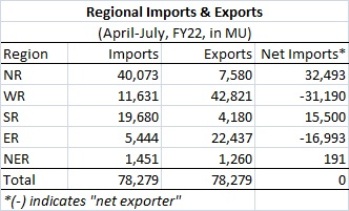The volume of interregional electricity exchange rose 16.6 per cent year-on-year in the first four months (April to July) of FY22, according to latest statistics released by National Load Dispatch Centre (NLDC).
The volume of interregional exchange stood at 78,279 MU in the first four months of FY22, as against 67,152 MU in the same period of FY21. [MU = million units = million kwh = GWh]
Interregional electricity exchange refers to transactions between the five regional grids of India – northern (NR), western (WR), southern (SR), eastern (ER) and northeastern (NER).
The largest chunk of transfer was WR-NR (from WR to NR) that stood at 29,467 MU in the April-July period of FY22. This was also 28.3 per cent higher than the comparable volume of FY21.
Another important interregional exchange was ER-SR that stood at 11,211 MU in the first four months of FY22. This was however 9.3 per cent lower than in the same period of FY22.
The bipolar 800kV Champa-Kurukshetra UHVDC line continued to be the biggest agent for interregional transfer. During the first four months of FY22, this line transferred 5902 MU, from WR to NR, accounting for 7.5 per cent of the total interregional transfer. Interestingly, the entire flow was in the given direction, there was zero transfer from NR to WR.
 The newly-commissioned bipolar 800kV Raigarh-Pugalur HVDC line, connecting WR and SR, was an interesting case. During the first four months of FY22, WR-SR transfers have progressively decline and the line is being increasingly used for SR-WR transfers. WR-SR transfers dropped consistently from 1392 MU in April 2021 to 113 MU in July 2021. On the other hand, SR-WR transfers in July 2021 stood at 732 MU, sharply rising from 127 MU in June and 51 MU in May 2021.
The newly-commissioned bipolar 800kV Raigarh-Pugalur HVDC line, connecting WR and SR, was an interesting case. During the first four months of FY22, WR-SR transfers have progressively decline and the line is being increasingly used for SR-WR transfers. WR-SR transfers dropped consistently from 1392 MU in April 2021 to 113 MU in July 2021. On the other hand, SR-WR transfers in July 2021 stood at 732 MU, sharply rising from 127 MU in June and 51 MU in May 2021.
The Raigarh-Pugalur line is essentially meant for transfers from WR to SR, while allowing for reverse flow whenever there is surplus renewable energy generation in the southern region.
Regional performance
NR was the biggest importer of electricity during the first four months of FY22, with recorded volume of 40,073 MU. WR was the largest exporter with 42821 MU in the April-July period of FY22. With imports of just 11,631 MU, WR was indeed a net exporter of electricity to the tune of 31,190 MU. [In normal course, WR is known to be a consumption centre. Therefore higher exports reflect growth in local power generation.] ER was also a net exporter to the order of 16,993 MU. On the other hand, NR was a net importer with a volume of 32,493 MU, and so was SR with 15,500 MU in the first four months of FY22. (See table above).



